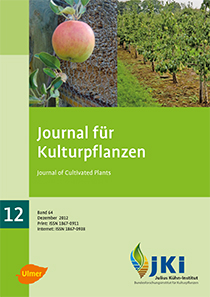Occurrence of Soil-borne wheat mosaic virus (SBWMV-NY) in Schleswig-Holstein and its importance for wheat cultivation
Keywords:
Soil-borne furoviruses, Soil-borne wheat mosaic virus-strain New York, Schleswig-Holstein, winter wheat, resistanceAbstract
The study of soil-borne viruses in Schleswig-Holstein shows an increasing distribution of Soil-borne wheat mosaic virus (SBWMV) in wheat and rye growing areas in this federal state of Germany. Whereas the Nebraska (N) strain of this virus was found in Southern Germany, the New York (NY) strain is present in Northern Germany. Selective wheat cultivars were screened for resistance to this virus under greenhouse conditions in an infested soil sample with the aim to develop recommendations for growers. Furthermore, the identification of the diagnostic marker Xgwm469-5D (153 bp- or 155 bp-allel) for the Sbm1-resistance gene against furoviruses was carried out in the wheat material under investigation. As a result of our work, the cultivation of the wheat cultivars Farandole, Hyland, Hybery, Mirage and Carenius is recommended for SBWMV-NY affected fields.
DOI: 10.5073/JfK.2012.12.03, https://doi.org/10.5073/JfK.2012.12.03








